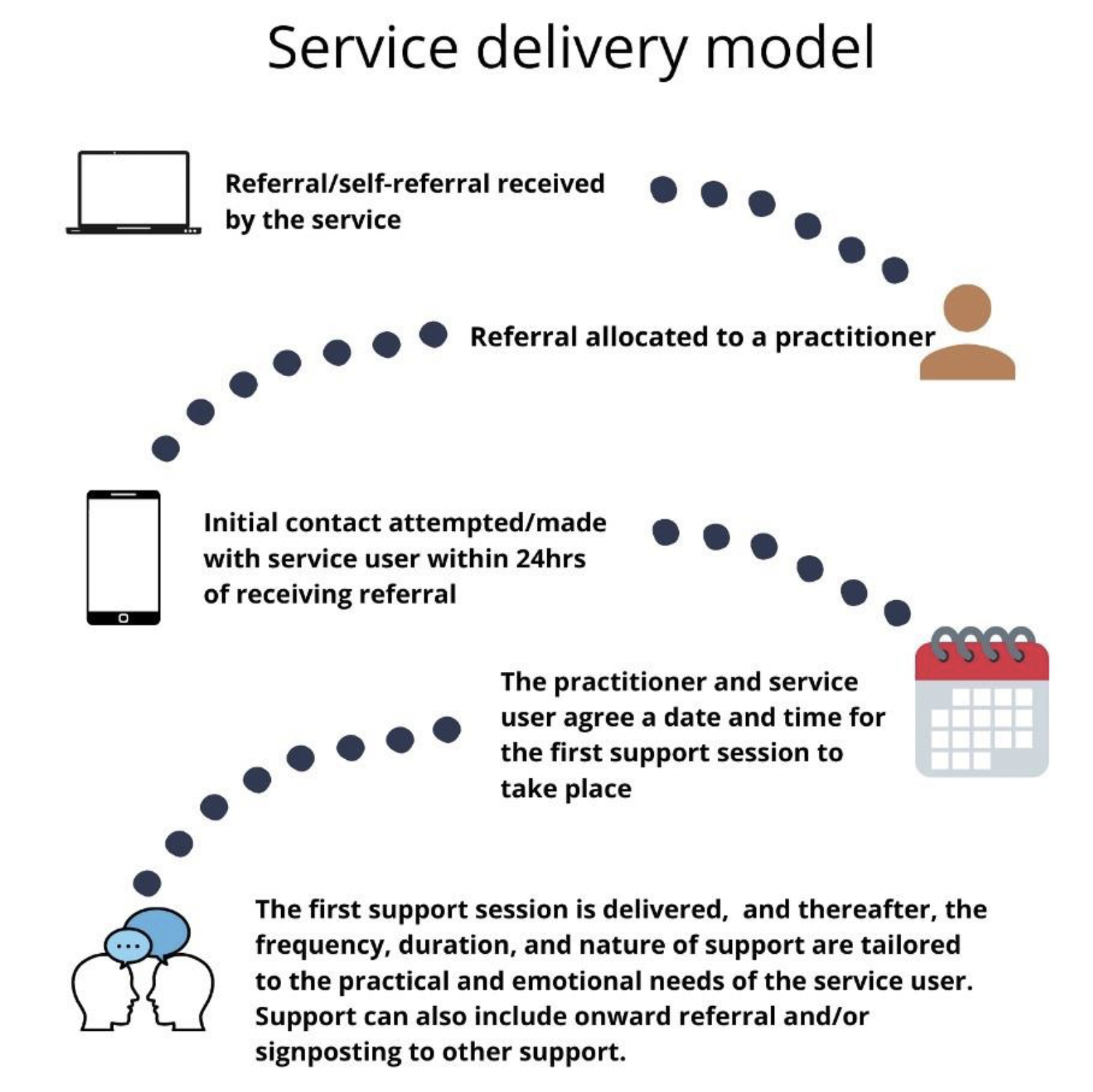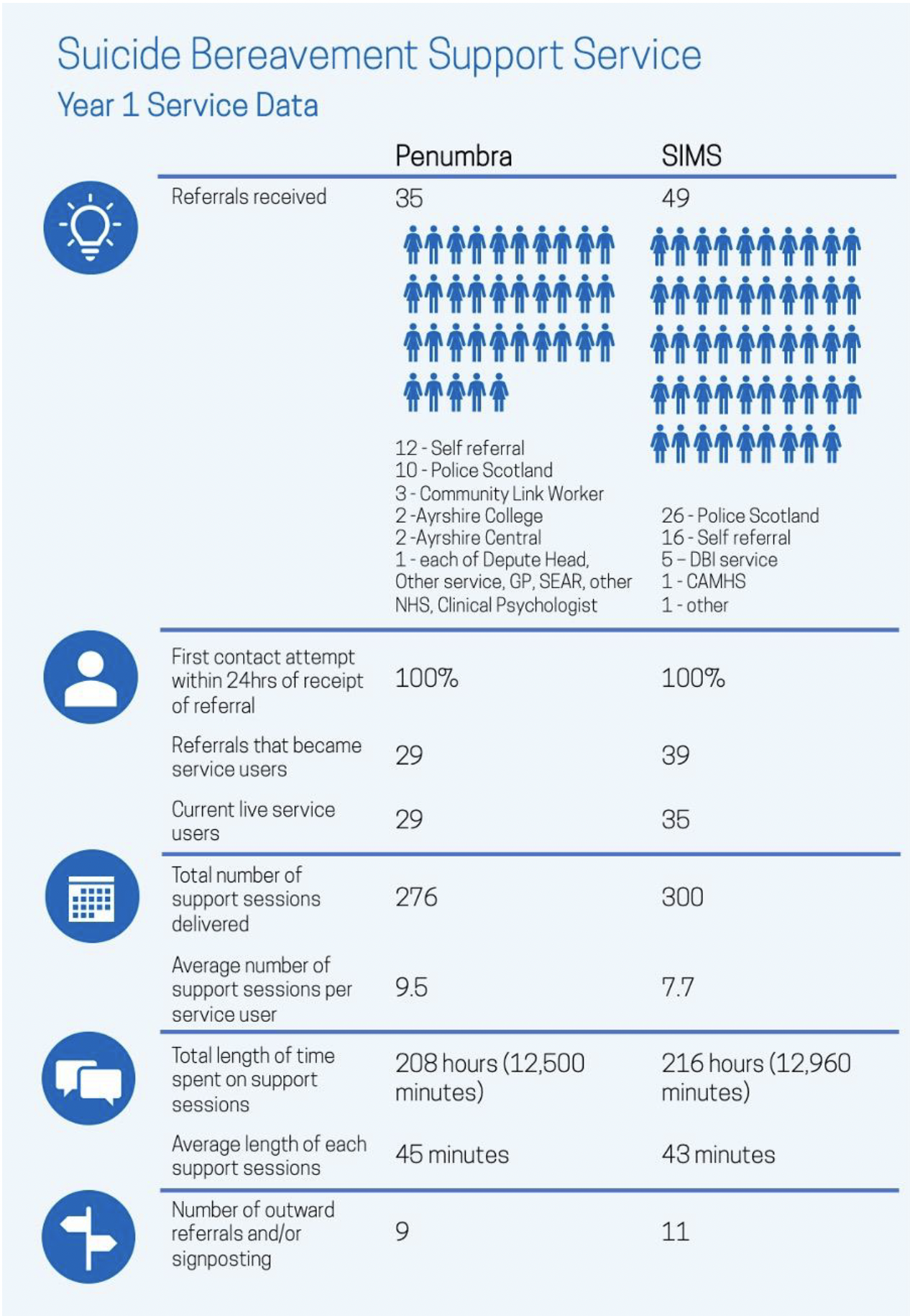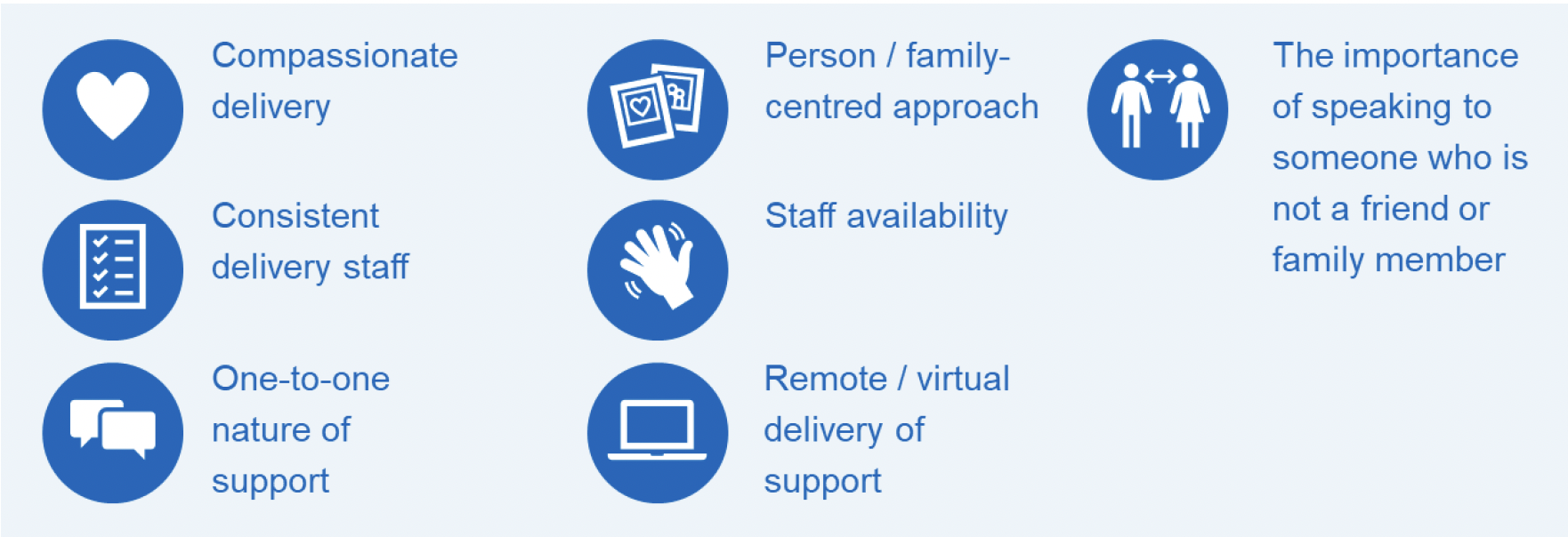Suicide Bereavement Support Service - year one: evaluation summary
This is a summary of the findings from the evaluation of the first year of the Suicide Bereavement Supporting Service pilot, prepared by The Lines Between. The pilot aims to provide flexible and personalised support to families who have experienced bereavement by suicide.
Evaluation of the Suicide Bereavement Support Service : Year One Summary : September 2022
Background to the service and evaluation
There is clear evidence of the negative impact of a suicide. People bereaved by the sudden death of a close friend or family member are estimated to be 65% more likely to attempt suicide if the deceased died by suicide than if they died by natural causes.[1]
Scotland's Suicide Prevention Strategy (2013-2016) provided a foundation for the publication of the Suicide Prevention Action Plan (Every Life Matters) in 2018. In the same year the National Suicide Prevention Leadership Group (NSPLG) was formed. This group has responsibility for delivering on a programme of activity and driving the implementation of the plan's actions. The NSPLG's Annual Report in 2019 included a recommendation that the Scottish Government make funding available to pilot a new model of care for those bereaved by suicide.
In response to this, the Scottish Government is funding a pilot service to support people bereaved by suicide, which builds on the findings from relevant research and other evidence and good practice models. The pilot service will be independently reviewed to learn how best to support families bereaved by suicide. The evaluation will also help inform future planning of bereavement support services.
The Suicide Bereavement Support Service (SBSS) aims to provide flexible and personalised support to families who have experienced bereavement by suicide, meeting their practical and emotional support needs for as long as is needed.
Working in partnership, Penumbra and Support in Mind Scotland (SIMS) were commissioned to manage and deliver the pilot in two Health Board areas over two years. The service launched at the start of August 2021 with Penumbra leading delivery in Ayrshire and Arran and SIMS leading delivery in Highland.
An evaluation has been commissioned with the key aims of:
- Understanding whether the pilot has been implemented as intended and the elements of service provision that are working well and less well;
- Assessing whether the service is providing flexible support and making the required connections with specialist services;
- Reviewing whether the service is considered to be supportive and beneficial by service users;
- Analysing available data, and review and advise on the use of baseline and outcomes measures for service monitoring and evaluation;
- Making recommendations for any service improvements that can be implemented during the pilot period and provide recommendations for further national roll-out.
The key research questions are:
- To what extent have the pilots delivered on their intended aim to provide a rapid response and liaison service for bereaved families?
- What contextual factors have influenced the implementation and delivery of the pilots?
- What has been the experience and short-term outcomes for those using the service?
- To what extent can the impact and benefits for families be evaluated and are there improvements that can be made to routine monitoring data?
- What are the key lessons for further roll out and scale up and sustainability of the service?
Evaluation activity carried out from August 2021 to May 2022 is summarised below:
- Engagement with a panel of people with lived experience of bereavement through suicide to inform the development of the evaluation approach and tools;
- Development of the evaluation framework underpinning delivery of the evaluation
- Work with pilot delivery organisations to embed tools and processes to support evidence collection and recruitment of service users to participate in interviews;
- Collection and analysis of service monitoring data;
- Collection and analysis of available Short Warwick Edinburgh Mental Wellbeing Scale (SWEMWBS) data – administered three times by service staff with consenting service users (baseline, three-months and six-months);
- One-to-one interviews with:
- SBSS staff;
- Organisations that make referrals into the service and/or receive referrals from the service;
- A sample of service users that have accessed the service.
Learning from service implementation and delivery
The key findings from the first annual report are summarised below. The key points are:
- The partnership between Penumbra and SIMS is working well, and the training and support for service staff has enabled them to provide effective support to service users.
- While COVID-19 meant that the support delivered by the service was predominantly provided over the telephone or video call, this has not had a negative impact on service user's experience of the service.
- Service user feedback indicates that they are benefitting from the support they have received, and would like to see the service continue.
Partnership approach: The partnership between Penumbra and SIMS is working well, with strong cooperation and collaboration between the service teams in each organisation. This has helped to create a supportive environment where service staff across the two pilot areas feel part of a cohesive single team.
Service model: The components of the service model are broadly consistent across both areas, although a small number of differences have been identified (e.g. data collection processes and staffing structures). Service staff are aware of these, and work is underway to address them where appropriate.
Delivery model: An overview of the service delivery model is provided below:

The delivery model in both areas is underpinned by a person-centred approach that is compassionate and is responsive to service user needs and circumstances. The service provides practical and emotional support for as long as the service user wants and needs it. The provision of emotional support has been the most prominent aspect of support that service users seek, although the identification of practical support needs has been increasing
Delivery overview: Monitoring data provided by the service, covering the period August 2021 to the end of March 2022, is set out in the infographic below.

A total of 84 referrals have been received by the service since its launch. Of the 49 referrals received by the service in Highland, 39 have gone on to engage with support. Of the 35 referrals received in Ayrshire and Arran, 29 have engaged with support. Across the two areas, 64 service users are currently engaged with the service. A total of 576 support sessions had been delivered at the end of March 2022, an average of nine per service user. Each session 44 minutes on average.
Format and mode of support: Most support sessions are delivered in a one-to-one format, though there have been a small number of instances when a family unit or a couple have participated in support sessions together. Valuable learning about supporting different members of a household or family unit has emerged and this relates to maintaining confidentiality and navigating the dynamics and relationships of a family unit. Due to COVID-19 restrictions, most support has been delivered by video or telephone call.
Face-to-face support: The introduction of face-to-face support sessions is being explored, though there are several factors that need to be considered to ensure they can be provided across the geography of both areas. However, service users' feedback suggests that demand for face-to-face support sessions could be low, with most reporting a preference for the convenience of remote support and being in a place where they felt comfortable.
Children and young people: Staff feel that face-to-face support may be a more effective way of engaging with younger people. While only a small number of young people have been referred into the service and engaged with support, staff have observed challenges engaging them through telephone and video calls.
Referral pathways: Referral pathways into the service have been extended in both areas beyond the sole initial pathway through Police Scotland. In Highland, the level of referrals from Police Scotland has remained fairly consistent. However, the extended referral pathways have not yet led to referrals from a wider variety of organisations. In Ayrshire and Arran the extension to referral pathways has resulted in a greater variety of referral sources, though this has coincided with a drop in the level of referrals being received from Police Scotland.
Phased implementation: Taking a phased approach to extending referral routes has enabled the service to embed their delivery model and manage demand for the service while trying to recruit a full staff complement, and build their experience. As this has now been achieved, albeit while managing staff turnover, a more concerted and focused effort to establish new referral pathways into the service can begin.
Wider support landscape: Service staff have a good awareness of the various support provision and resources available both locally and nationally, and this knowledge and awareness continues to be developed. While referral activity to other support and provision has been fairly low, this is largely because most service users are receiving what they need from the SBSS.
Training and support: A comprehensive initial training programme, supplemented by ongoing development opportunities, has ensured that practitioner staff feel equipped to provide practical and emotional support that meets service users' needs. The support that staff receive is comprehensive and is meeting their needs. Certain aspects of the support, such as reflective practice sessions, also enable continuous improvement and development. This has enhanced and built greater consistency in the skills and knowledge base of the staff team.
Staff recruitment and retention: In both areas, the service has experienced challenges in terms of staff continuity and long term leave. This has resulted in several existing service users transferring to another practitioner. As consistency of practitioner is highly valued by service users, this will need ongoing attention and management.
Service user experience and outcomes
A total of 16 service users (12 Highland and four Ayrshire and Arran) provided their consent to participate in the evaluation. They were each invited to, and participated in a one-to-one interview with a member of the evaluation team. Discussions with service users has been essential in developing insight and understanding of the service user experience, the factors that influence it, and the difference that the support provided through the service is making. The feedback gathered about the service has been overwhelmingly positive, with the following aspects being highlighted:

Key Strengths of the service:
- Feedback indicates the service provides important and comprehensive practical and emotional support for service users. Service users reported the service helped them access other services and forms of support where appropriate.
- Service users value the service being tailored to people bereaved by suicide and were unsure where else they could access this, or similar support if the service did not exist. Service users also reported that the service contacted them quickly after the referral being made.
- There is evidence that the service has had a positive impact on service users, most notably in helping them to cope better with day-to-day life and to improve their own mental wellbeing. For these reasons, service users would like to see the service continue.
Areas for improvement:
- Referral pathways into the service could be improved, and general awareness of the service increased. Service users suggested this would help to ensure that referrals are made more promptly, so that people needing support can receive it.
Service user outcomes:
The table below provides a breakdown of each of the intended service user outcomes, and a summary describing the extent to which they are being achieved
| Outcome | Summary |
|---|---|
| People bereaved by suicide are able to access (referred or self-referral) the SBSS service easily and in a timely manner. | Not all service users have reported being able to access the service in a timely manner. This is not entirely in the control of the service but does mean that this outcome is not being achieved for all service users. |
| People bereaved by suicide are signposted/referred to, and are supported to access local sources of support that are relevant to and able to support their needs. | Signposting and referrals are being used appropriately to meet service user needs. This indicates that this outcome is being achieved. |
| People bereaved by suicide experience the SBSS as providing support that is compassionate, relevant to their needs and is person/family-centred. | Consistent feedback regarding the compassionate nature of service staff and the person-centred approach taken suggests that this outcome is being met. |
| People bereaved by suicide are better able to cope with day-to-day life. | The service has provided practical and emotional support that has helped service users to feel better able to cope with day-to-day life. Evidence gathered indicates that this outcome is being achieved. |
| People bereaved by suicide experience improved mental wellbeing as a result of the support they have received. | Quantitative and qualitative evidence relating to improved wellbeing provides a strong indication that this outcome is being achieved. |
Recommendations
Training and Development: While the initial training that frontline practitioners undertake is comprehensive, it could be further enhanced through the development of an internal training resource which draws on the experiences of staff that have been supporting service users.
Support for practitioner staff: If the practical and logistical challenges of bringing the teams from each area together can be overcome, reflective practice sessions involving all service staff should be considered. This would complement and supplement existing support mechanisms and help to maximise the sharing of learning and experience across the whole service.
Supporting children and young people: To overcome challenges experienced by the service in engaging young people in support over video call and telephone, exploring the feasibility of an online chat function/platform is recommended. As part of this it will be important to test the concept at an early stage with young people that have lived experience.
Easy and timely access to the service: Feedback from Police Scotland staff provided insight into the barriers they can face to making a referral into the service. It is recommended that a backup process is explored with Police Scotland, to support situations when a police officer has attended a suicide but has not been able to discuss the service and a potential referral with the bereaved. This would ensure that a follow up is undertaken and the offer of a referral made. Aligned to the above we would also recommend that steps are taken to increase awareness of the service among the general public. This could increase the likelihood of someone that has experienced a bereavement by suicide of self-referring into the service if other opportunities to refer have been missed.
Contact
There is a problem
Thanks for your feedback